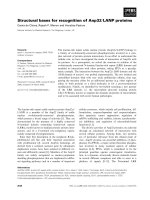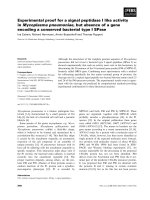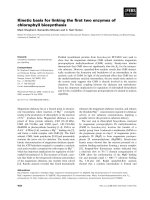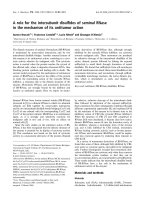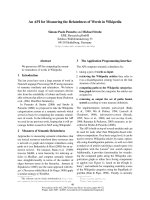Báo cáo " Calculation of Morse Potential for Diamond Crystals. Applification to Anharmonic Effective Potential " docx
Bạn đang xem bản rút gọn của tài liệu. Xem và tải ngay bản đầy đủ của tài liệu tại đây (105.9 KB, 7 trang )
VNU Journal of Science, Mathematics - Physics 24 (2008) 125-131
125
Calculation of Morse Potential for Diamond Crystals.
Applification to Anharmonic Effective Potential
Nguyen Van Hung*, Nguyen Cong Toan, Nguyen Bao Trung, Ngo Hoang Giang
Department of Physics, College of Science, VNU, 334 Nguyen Trai, Thanh Xuan, Hanoi, Vietnam
Received 26 June 2008; received in revised form 15 August 2008
Abstract. Analytical expressions for the Morse potential parameters of diamond crystals have
been derived. They contain the energy of sublimation, the compressibility and the lattice constant.
Numerical calculations have been carried out for Si and Sn, and the results reflect fundamental
properties of this potential. The obtained Morse potential parameters have been used for
calculation of the anharmonic correlated effective potentials of these crystals in XAFS theory
showing clearly anharmonic effects .
1. Introduction
Interatomic anharmonic potential, especially Morse potential, has been studied widely [1-12].
The parameters of this potential can be extracted from the XAFS (X-ray Absorption Fine Structure)
[11,12]. They are also used to calculate thermodynamic parameters included in these spectra [4-10].
This potential is successfully applied to calculating the quantities involving atomic interaction,
especially, the anharmonic effects contained in XAFS [5-10] which influence on the physical
information taken from these spectra. They are also contained in the expressions of equation of state
[1]. Therefore, calculation of the Morse potential is very actually desired, especially in XAFS theory.
The calculation of Morse potential has been carried out for fcc, bcc [1,22 ] and hcp [17,22] crystals.
The purpose of this work is to develop a method for calculation of Morse potential parameters
of Diamond, an interesting crystal structure. Analytical expressions for the parameters of this potential
have been derived. They contain the energy of sublimation, the compressibility and the lattice constant
which are known already, for example see [13,18,21]. The obtained results are applied to calculating
the anharmonic correlated effective potential, contained in the XAFS spectra [4-10,14]. Numerical
calculations have been carried out for volume per atom, tructural parameters and Morse potential
parameters of Diamond crystals Si and Sn. The obtained Morse potential parameters satisfy all
fundamental properties of this potential [19] and have been applied to calculating anharmonic
correlated effective potentials of these crystals in XAFS theory.
______
*
Corresponding author. E-mail:
N.V. Hung et al. / VNU Journal of Science, Mathematics - Physics 24 (2008) 125-131
126
2. Procedure for calculation of Morse potential of Diamond crystals
The potential energy
(
)
ij
r
ϕ
of two atoms i and j separated by a distance
ij
r is given in terms of
the Morse function by
( )
2
2
ij
r r r r
o o
ij ij
r D e e
α α
ϕ
− −
− −
= −
, (1)
where D,
α
are constants with dimensions of reciprocal distance and energy, respectively;
o
r is the
equilibrium distance of the two atoms. Since
(
)
,
o
r D D
ϕ
= − is the disociation energy.
In order to obtain the potential energy of the whole crystal whose atoms are at rest, it is
necessary to sum Eq. (1) over the entire crystal. This is most easily done by choosing one atom
in the lattice as an orgin, calculating its interaction with all the others in the crystal, and then
multiplying by
2/N
, where N is the total atomic number in the crystal. Thus the total energy
Φ
is
given by
2
1
2
2
j
r r r r
o o
j j
ND e e
α α
− −
− −
Φ = −
∑
. (2)
Here
j
r is the distance from the origin to the jth atom. It is convenient to define the following
quantities
1/ 2
2 2 2
1
; ;
2
o
j j j j j
r
L ND e r m n l a M a
α
β
= = = + + =
, (3)
where
jjj
lnm ,, are position coordinates of any atom in the lattice. Applying Eq. (3) to Eq. (2), the
energy can be rewritten as
( )
2
2
2
j j
j j
aM aM
a L e L e
α α
β β
−−
Φ = −
∑ ∑
. (4)
The first and second derivatives of the energy of Eq. (4) with respect to
a
are given by
2
2
2 2
j j
j j
j j
aM aM
d
L M e L M e
da
α α
α β βα
− −
Φ
= − +
∑ ∑
, (5)
2
2 2 2 2 2
2
2
4 2
j j
j j
j j
aM aM
d
L M e L M e
da
α α
α β α β
−−
Φ
= −
∑ ∑
. (6)
At absolute zero T = 0,
o
a is value of
a
for which the lattice is in equilibrium, then
(
)
o
aΦ gives the
energy of cohesion,
[
]
0
/ 0
a
d da
Φ =
, and
0
2 2
/
a
d da
Φ
is related to the compressibility [1]. That is,
(
)
(
)
0 0 0
a U a
Φ = , (7)
where
(
)
00
aU is the energy of sublimation at zero pressure and temperature, i., e.,
0
0
a
d
da
Φ
=
, (8)
and the compressibility is given by [1]
0
0
2
2
0
0 0
2 2
00
1
a
a
d U
d
V V
K dV dV
Φ
= =
, (9)
N.V. Hung et al. / VNU Journal of Science, Mathematics - Physics 24 (2008) 125-131
127
where
0
V is the volume at T = 0, and
00
K is compressibility at zero temperature and pressure. The
volume per atom
NV
v
/
=
is related to the lattice constant
a
by the relation [1]
3
/
ca
V N = . (10)
Substituting Eq. (10) in Eq. (9) the compressibility is expressed by
0
2
2
00 0
1 1
9
a a
d
K cNa da
=
Φ
=
. (11)
Using Eq. (5) to solve Eq. (8) we obtain
2
/
j j
j j
j j
aM aM
M e M e
α α
β
− −
=
∑ ∑
. (12)
From Eqs. (4, 6, 7, 11) we derive the relation
0 00
2 2 2 2
0
2
2
2
9
4 2
j j
j j
j j
j j
j j
aM aM
aM aM
e e
U K
cNa
M e M e
α α
α α
β
α β α
− −
− −
−
=
−
∑ ∑
∑ ∑
. (13)
Solving the system of Eqs. (12, 13) we obtain
,
α β
. Substituting the obtained results into the
second of Eq. (3) we derive
0
r . Using the obtained
,
α β
and Eq. (4) to solve Eq. (7) we obtain L.
From this L and the first of Eq. (3) we obtain D. The obtained Morse potential parameters
α
,D
depend on the compressibility
00
K , the energy of sublimation
0
U and the lattice constant
a
. These
values of about all crystals are known already [13,16,18,21].
3. Application to calculation of anharmonic correlated effective potential in XAFS
Figure 1 shows Fourier transform magnitudes of XAFS of Sn (Diamond), measured at 77K and
300K at HASYLAB (DESY, Germany) [20]. They are different at these temperatures by the shift of
the curves showing anharmonic effects in XAFS. For describing these effects an anharmonic XAFS
theory is necessary.
Fig. 1 Fourier transform magnitudes of XAFS of Sn at 77K and 300K.
Sn
9Å
-1
< k < 18Å
-1
R(Å)
0 2 4 6 8
Fourier transform magnitude
0.00
0.02
0.04
0.06
0.08
0.10
0.12
0.14
0.16
77K
x4, 300K
N.V. Hung et al. / VNU Journal of Science, Mathematics - Physics 24 (2008) 125-131
128
The expression for the K-edge anharmonic XAFS function [10] is described by
( )
( )
2 / ( )
2
( )
(2 )
( ) Im exp 2
!
n
n
n
R k
i k
e ik
k F k e ikR
n
kR
λ
χ σ
−
Φ
= +
∑
, (15)
where )(kF is the real atomic backscattering amplitude,
Φ
is net phase shift,
k
and
λ
are the wave
number and the mean free path of the photoelectron, respectively, and
σ
(n)
(n = 1,2,3, …) are the
cumulants. The expression for the cumulants in XAFS theory is derived based on the anharmonic
correlated Einstein model [9] which is considered, at present, as “the best theoretical framework with
which the experimentalist can relate force constants to temperature dependent XAFS” [15]. According
to this theory the effective interaction Einstein potential of the system is given by
( ) ( )
2 3
3 12
1
ˆ ˆ
.
2
eff eff ij
i
j i
V x k x k x V x V x
M
µ
≠
≅ + + = +
∑
R R
L ,
1 2
1 2
ˆ
,
M M
M M
µ
= =
+
R
R
R
. (16)
Here
eff
k is effective force constant, and
3
k the cubic parameter giving an assymmetry in the
pair distribution function, r is bondlength and
0
r is its equilibrium value. The correlated Einstein
model may be defined as a oscillation of a pair of atoms with masses
1
M and
2
M (e.g., absorber and
backscatterer) in a given system. Their oscillation is influenced by their neighbors given by the last
term in the left-hand side of Eq. (16), where the sum
i
is over absorber (
1
=
i
) and backscatterer
(
2
=
i
), and the sum
j
is over all their near neighbors, excluding the absorber and backsctterer
themselves. The latter contributions are described by the term
(
)
xV .
Applying the Morse potential of Eq. (1) in the approximation for weak anharmonicity to the
XAFS theory by the expansion
(
)
(
)
0
2 2 2 3 3
( ) 2 1 ,
x x
V x D e e D x x x r r
α α
α α
− −
= − ≅ − + − + = −
L , (17)
so that the anharmonic effective potential Eq. (16) is transformed as
(
)
(
)
2 3 2 3 3
1 3 3
3 , ,
eff
V y D c c a y c D y y x a a x
α α α
= + + = − = , (18)
with the effective local force constant and cubic parameter
(
)
2 3 3
1 3 3 3
2 3 ,
eff
k D c c a k c D
α α α
= + = , (19)
and structural parameters
2 3
1 3
2 2
cos cos
1 , 1
2 4
N N
j j
j j
c c
α α
= =
= + = − +
∑ ∑
. (20)
4. Numerical results and discussion
To calculate the above equations to obtain the Morse potential parameters, we have to calculate
the parameter c in Eq. (10). The space lattice of diamond is fcc. The primitive basis has two identical
atoms at 000,
4
1
4
1
4
1
associated with each point of the fcc lattice. Thus the conventional unit cube
contains eight atoms, so that we obtain the value c = 1/8 for this tructure.
N.V. Hung et al. / VNU Journal of Science, Mathematics - Physics 24 (2008) 125-131
129
Using the theory derived in the previous section and the calculated parameter c, as well as the
energy of sublimation, the compressibility and the lattice constant from [13,16,18,21] we calculated
Morse potential parameter
0
,, rD
α
by our established computing programs and the results are included
in Table 1.
Fig. 2. Nearest neighbors of absorber (A) and backscatterer (S) in XAFS of diamond crystal.
Table 1. Calculated Morse potential parameters for Diamond crystals Si and Sn
Crystal D(eV)
α
(Å
-1
)
o
r (Å)
Si 0.9956 1.3621 2.8439
Sn 1.3189 2.0504 2.8813
Based on the coordinates of neighbors and central atom (Fig. 2) presented in Table 2 we
Table 2. Coordinates of neighbors of a central atom in diamond structure
Atomic number
x y z
cos(R
01
.R
ij
)
1 -1/4 -1/4 -1/4
2 1/4 1/4 -1/4 -1/3
3 1/4 -1/4 1/4 -1/3
4 -1/4 1/4 1/4 -1/3
calculated the structural paremeters
( )
2 2 2
1 2 3 4
3 3 3
3 2 3 4
1 cos / 2 cos / 2 cos / 2 7 / 6.
1 cos / 4 cos / 4 cos / 4 35/ 36.
c
c
α α α
α α α
= + + + =
= − + + + = −
(21)
Hence, for diamond the anharmonic correlated effective potential from Eq. (18) is resulted as
( )
2 2 3 3
7 35
6 36
eff
V x D x D x
α α
≅ − , (22)
( )
2 3 2 3 3
7 105 35
6 36 36
eff
V y D a y D y
α α α
= − −
. (23)
Figure 3 shows the calculated Morse potentials of Si and Sn. They satisfy all properties of the Morse
potential [19], i. e., it describes repulsive force in short distance when atoms approach each other
obeying Pauli exclusion principle, and describes attractive force in long distance when atoms go far
N.V. Hung et al. / VNU Journal of Science, Mathematics - Physics 24 (2008) 125-131
130
from each other. The reason of this
attraction is that the atoms have diffusion
moments which attract each other in long
distance. Figure 4 illustrates the
calculated anharmonic and harmonic
effective potentials for Si and Sn. They
show strong asymmetry of these
potentials due to including anharmonic
contributions in atomic vibrations of these
diamond crystals.
Fig. 3. Calculated Morse potentials for Si and Sn.
Fig. 4. Calculated anharmonic and harmonic effective potentials for Diamond
crystals Si (a) and Sn (b) showing strong anharmonic shifting.
5. Conclusions
A new procedure for calculation of Morse potential parameters for Diamond crystals has been
developed and the obtained results are applied to calculation of anharmonic and harmonic potential in
the XAFS theory. The derived expressions have been programed for the computation of the considered
physical quantities.
The derived expressions for Morse potential parameters contain the energy of sublimation, the
compressibility and the lattice constant of Diamond crystals which are available in literatures.
The good satisfying of the calculated Morse potential with its fundamental properties, as well
as, the good description of the effective potentials and the asymmetry of this potential due to
anharmonicity show the efficiency and reliability of the present procedure in computation of the
N.V. Hung et al. / VNU Journal of Science, Mathematics - Physics 24 (2008) 125-131
131
atomic interaction potential parameters as the Morse potential which are important for calculation and
analysis of physical effects in XAFS technique and in solving the problems involving any type of
atomic interaction in the Diamond crystals.
Acknowledgments: The authors thank Dao Xuan Viet and Le Duy Manh for useful
contributions to numerical calculation of Morse potential parameters. This work is supported in part
by the basic science research program No. 4 058 06.
References
[1] L.A. Girifalco, V.G. Weizer, Phys. Rev. 114 (1959) 687.
[2] E.C. Marques, D.R. Sandrom, F.W. Lytle, R.B. Greegor, J. Chem. Phys. 77 (1982) 1027.
[3] E.A. Stern, P. Livins, Z. Zhang, Phys. Rev. B 43 (1991) 8550.
[4] T. Miyanaga, T. Fujikawa, J. Phys. Soc. Jpn. 63 (1994) 1036 and 3683.
[5] T. Yokoyama, K. Kobayashi, T. Ohta, Phys. Rev. B 53 (1996) 6111.
[6] N.V. Hung, R. Frahm, Physica B 208-209 (1995) 91.
[7] N.V. Hung, R. Frahm, H. Kamitsubo, J. Phys. Soc. Jpn. 65 (1996) 3571.
[8] N.V. Hung, J. de Physique IV (1997) C2 : 279.
[9] N.V. Hung, J.J. Rehr, Phys. Rev. B 56 (1997) 43.
[10] N.V. Hung, N.B. Duc, R. Frahm, J. Phys. Soc. Jpn. 72 (2003) 1254.
[11] I.V. Pirog, I.I. Nedosekina, I.A. Zarubin, A.T. Shuvaev, J. Phys.: Condens. Matter 14 (2002) 1825.
[12] I.V. Pirog, T.I. Nedosekina, Physica B 334 (2003) 123.
[13] Charl. Kittel, Introduction to Solid-State Physics, John Wiley & Sons ed., Inc. New York, Chichester, Brisbane,
Toronto, Singapore (1986).
[14] See X-ray absorption, edited by D. C. Koningsberger and R. Prins (Wiley, NewYork,1988).
[15] M. Daniel, D.M. Pease, N. Van Hung, J.I. Budnick, Phys. Rev. B 69 (2004) 134414: 1-10.
[16] J.C. Slater, Introduction to Chemical Physics (McGraw-Hill Book Company, Inc., New York, 1939).
[17] N.V. Hung, D.X. Viet, VNU J. Science, Mathematics - Physics Vol. 19, No. 2 (2003) 19.
[18] Handbook of Physical Constants, Sydney P. Clark, Jr., editor published by the society, 1996.
[19] Morse, P.M., Atomic pair potential, Phys. Rev. B. 34 (1929) 57.
[20] R.R. Frahm, N.V. Hung (unpublished).
[21] J.C. Slater, Introduction to Chemical Physics (McGraw-Hill Book Company, Inc., New York, 1939).
[22] N.V. Hung, Communications in Physics Vol. 14, No. 1 (2004) 7.


